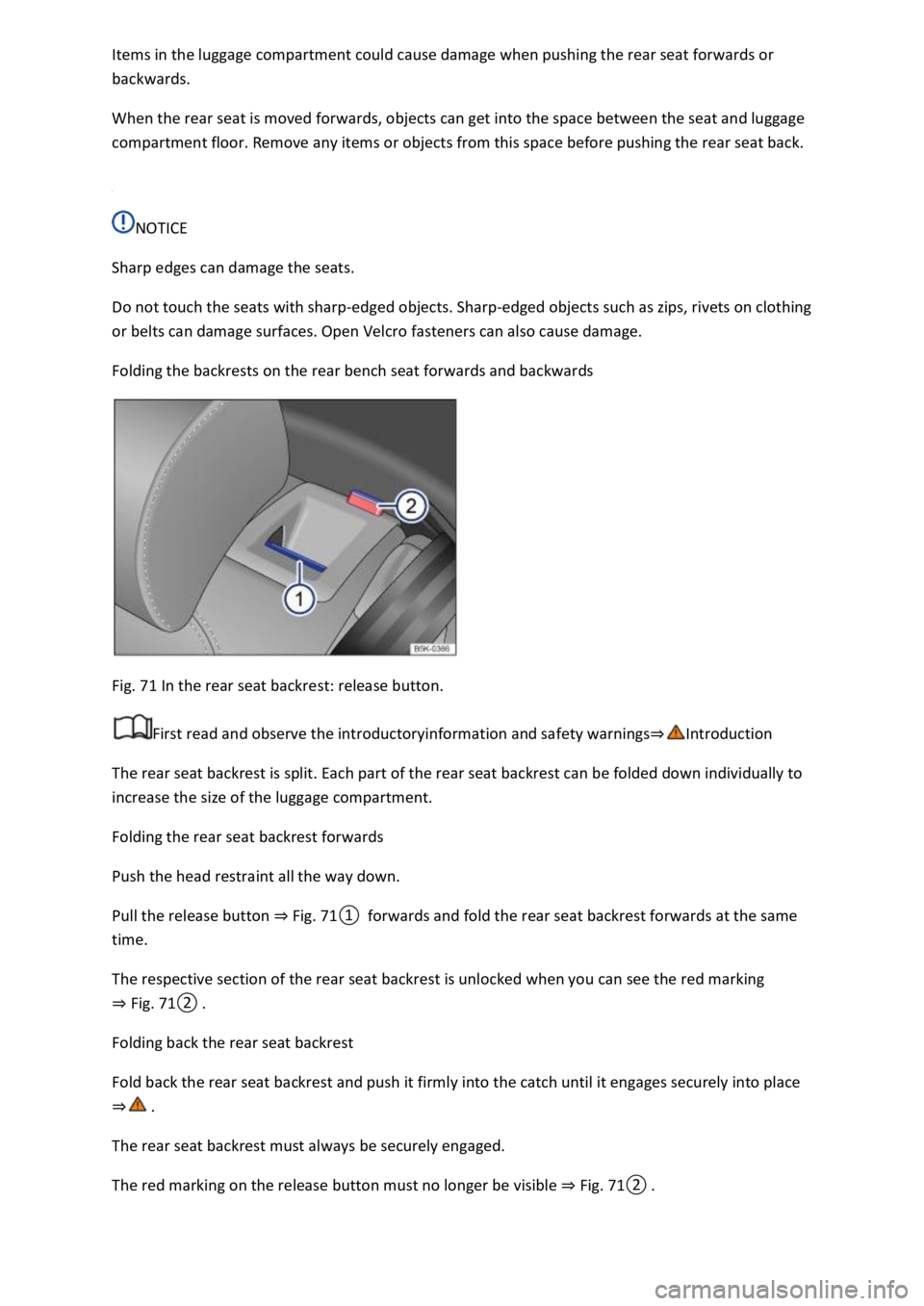2021 VOLKSWAGEN T-ROC remove seats
[x] Cancel search: remove seatsPage 79 of 502

Fig. 45 Illustration: airbag label on the B-pillar.
First read and observe the introductoryinformation and safety warnings⇒Introduction
Country-specific requirements
The standards and regulations governing the use of child seats and child seat securing mechanisms
differ from country to country. Not all countries allow you to transport children on the front
passenger seat. Legislation and legal requirements take precedence over the information given in
this owner's manual.
Information on fitting a child seat
Observe the following general information when fitting a child seat. This information is relevant
whatever child seat securing system is being used.
Read and follow the instructions provided by the child seat manufacturer ⇒ .
Whenever possible, fit all child seats to the rear seat behind the front passenger seat so that
children can exit the vehicle on the kerb side.
Adjust the seat belt height adjuster to the highest position.
When fitting on the front passenger seat, push the front passenger seat back fully and adjust the
seat to the highest position. Adjust the backrest to an upright position ⇒ Sitting position .
Always leave sufficient space around the child seat. If necessary, adjust the position of the seat in
front of it. When doing so, ensure that the driver or front passenger can still maintain a correct
sitting position ⇒ Sitting position .
The backrest of the child seat must lay as flat as possible against the vehicle seat backrest. If
necessary, adjust the seat backrest angle so that the child seat lies flush against the backrest. Once it
has been installed, if the child seat is touching the head restraint and therefore cannot be positioned
flush against the backrest, push the head restraint all the way up, or remove it and stow it securely
in the vehicle ⇒ Sitting position .
Airbag sticker
The vehicle may be provided with stickers giving important information about the front passenger
front airbag. The information on these stickers may vary from country to country. The stickers may
be provided at the following locations:
On the driver and/or front passenger sun visor ⇒ Fig. 44 .
Page 123 of 502

Items in the luggage compartment could cause damage when pushing the rear seat forwards or
backwards.
When the rear seat is moved forwards, objects can get into the space between the seat and luggage
compartment floor. Remove any items or objects from this space before pushing the rear seat back.
NOTICE
Sharp edges can damage the seats.
Do not touch the seats with sharp-edged objects. Sharp-edged objects such as zips, rivets on clothing
or belts can damage surfaces. Open Velcro fasteners can also cause damage.
Folding the backrests on the rear bench seat forwards and backwards
Fig. 71 In the rear seat backrest: release button.
First read and observe the introductoryinformation and safety warnings⇒Introduction
The rear seat backrest is split. Each part of the rear seat backrest can be folded down individually to
increase the size of the luggage compartment.
Folding the rear seat backrest forwards
Push the head restraint all the way down.
Pull the release button ⇒ Fig. 71① forwards and fold the rear seat backrest forwards at the same
time.
The respective section of the rear seat backrest is unlocked when you can see the red marking
⇒ Fig. 71② .
Folding back the rear seat backrest
Fold back the rear seat backrest and push it firmly into the catch until it engages securely into place
⇒ .
The rear seat backrest must always be securely engaged.
The red marking on the release button must no longer be visible ⇒ Fig. 71② .
Page 172 of 502

Eco driving profile ⇒ Driving profile selection and 4MOTION Active Control .
Avoid driving at full throttle
Never drive the vehicle at its top speed. The drag coefficient increases at excessively high speeds.
This in turn increases the force needed to move the vehicle.
Reduce idling
Pull away immediately with low engine speeds. If you are stopped for a long period, do not allow the
engine to idle but switch it off, e.g. when in a traffic jam or at a railway crossing.
In vehicles with an activated start/stop system, the engine can switch off automatically when the
vehicle is stopping and when the vehicle is stationary ⇒ Start/stop system .
Refuel moderately
A full fuel tank increases the weight of the vehicle. A fuel tank that is half or two thirds of the way
full is sufficient for journeys in urban traffic in particular.
Avoid short journeys
A cold engine has very high fuel consumption. The optimum operating temperature is reached only
after driving a few kilometres. The fuel consumption is above average at very low ambient
temperatures, e.g. in winter ⇒ Fig. 97 . Plan journeys economically and combine short journeys.
Carry out regular maintenance
Regular maintenance is an essential prerequisite for economical driving and increases the service life
of the vehicle.
Observe the tyre pressures
Low tyre pressures does not just mean greater wear, but also increase the rolling resistance of the
tyres and thus the fuel consumption. Use optimised rolling resistance tyres.
Adjust the tyre pressure according to the load. Observe the information on the tyre pressure sticker
⇒ Useful information about wheels and tyres
Tyre Pressure Loss Indicator or Tyre Pressure Monitoring System ⇒ Tyre monitoring system .
Use low viscosity engine oils
Fully synthetic engine oils with a low viscosity decrease frictional resistance in the engine and are
distributed better and more quickly, especially during cold starts.
Do not drive with unnecessary loads in the vehicle
You can reduce fuel consumption by clearing out the luggage compartment before setting off, for
example by removing empty drink crates or unused child seats.
To keep the vehicle's air resistance as low as possible, remove any add-on parts and equipment such
as ski racks, bicycle racks and roof carriers once you have finished using them.
Save electrical energy
Page 445 of 502

Rubber seals:
Clean with a soft, lint-free cloth and plenty of water. Treat with Volkswagen Genuine rubber care
agent (- 000 096 310 -) on a regular basis.
Seat belts:
Carefully pull the seat belt right out and leave it out ⇒ . Remove coarse dirt with a soft brush.
Clean the seat belt with a mild soap solution. Leave the belt fabric to dry completely and then allow
it to roll up.
Wooden trims:
Clean with a soft cloth and some mild soap solution1).
Cleaning upholstery fabrics
If clothing that is not sufficiently colour-fast, e.g. denim, leaves stains on the seat cushion, this is not
a defect in the cover fabric. The seat padding may contain components for the airbag system and
electrical connections. Seat padding that is damaged, incorrectly cleaned or treated, or that
becomes wet, may cause damage to the vehicle electrical system or cause a fault in the airbag
system ⇒ .
Depending on the equipment, seat cushions with seat heating feature electrical components and
connectors that may be damaged in the event of incorrect cleaning or treatment ⇒ . This can also
result in damage to other parts of the vehicle electrics.
-pressure cleaners, steam cleaners or cold spray.
n the seat heating to dry the seats.
WARNING
Incorrect cleaning can cause damage to the seat belts, the belt anchorages and the belt retractor.
belt buckles against the ingress of liquids and foreign bodies.
NOTICE
Page 449 of 502

Repairs and technical modifications must always be carried out according to Volkswagen
specifications⇒ .
Modifications and repairs to the front bumper, doors, front seats, headliner or the bodywork should
be carried out only by a qualified workshop. Airbag system components and sensors might be fitted
on these vehicle components.
If you work on the airbag system or remove and install parts of the system when performing other
repair work, parts of the airbag system may be damaged. The consequence may be that, in the event
of an accident, the airbag inflates incorrectly or does not inflate at all.
Regulations must be observed to ensure that the effectiveness of the airbags is not reduced and that
removed parts do not cause any injuries or environmental pollution. Qualified workshops are
familiar with these regulations.
Any modifications to the vehicle's suspension could prevent the airbag system from working
properly during a collision. For example, using wheel rim/tyre combinations that have not been
approved by Volkswagen, lowering the suspension or making modifications to the suspension rate
including work on the springs, struts and shock absorbers etc., could change the forces that are
measured by the airbag sensors and sent to the electronic control unit. Some changes to the
suspension could cause the forces measured by the sensors to increase, for example. This can lead
to the airbag system being triggered in collision scenarios where it normally would not be triggered if
modifications to the suspension had not been made. Other modifications can cause the forces
measured by the sensors to decrease, therefore preventing the airbag system from being triggered
when it should have been.
WARNING
Incorrect repairs and modifications can cause malfunctions and damage to the vehicle and impair
the effectiveness of the airbag system. This can result in accidents and serious or even fatal injuries.
en taken from end-of-life
vehicles in your vehicle.
WARNING
Modifications to the vehicle's suspension, including the use of unsuitable tyre/rim combinations, can
cause the airbag system to function differently and increase the risk of serious or fatal injuries in the
event of an accident.
the original factory-fitted components.
en.
Mobile reception in the vehicle